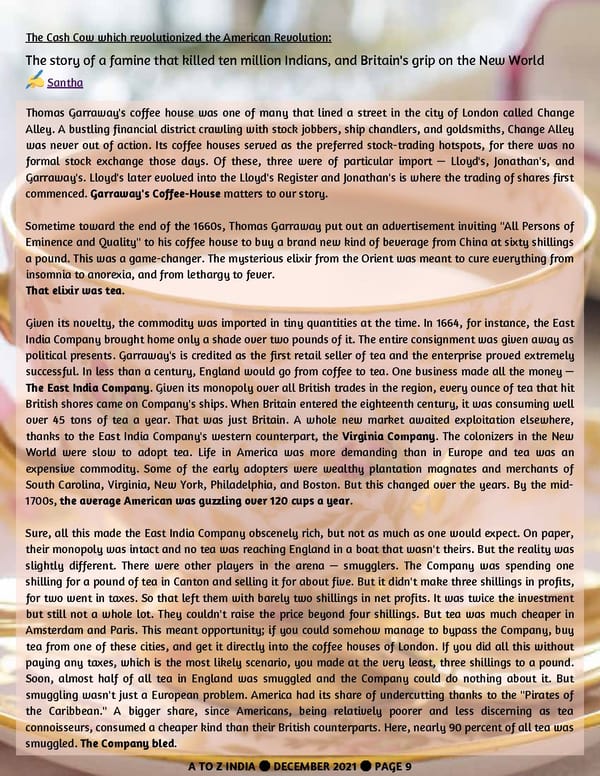Thomas Garraway's coffee house was one of many that lined a street in the city of London called Change Alley. A bustling financial district crawling with stock jobbers, ship chandlers, and goldsmiths, Change Alley was never out of action. Its coffee houses served as the preferred stock-trading hotspots, for there was no formal stock exchange those days. Of these, three were of particular import — Llo yd's, Jonathan's, and Garraway's. Lloyd's later evolved into the Lloyd's Register and Jonathan's is where the trading of shares first commenced. Garraway's Coffee-House matters to our story. Sometime toward the end of the 1660s, Thomas Garraway put out an advertisement inviting "All Persons of Eminence and Quality" to his coffee house to buy a brand new kind of beverage from China at sixty shillings a p ound. This was a game-changer. The mysterious elixir from the Orient was meant to cure everything from insomnia to anorexia, and from lethargy to fever. That elixir was tea. Given its novelty, the commodity was imported in tiny quantities at the time. In 1664, for instance, the East India Company brought home only a shade over two pounds of it. The entire consignment was given away as political presents . Garraway's is credited as the first retail seller of tea and the enterprise proved extremely successful. In less than a century, England would go from coffee to tea. One business made all the money — The East India Company . Given its monopoly over all British trades in the region, every ounce of tea that hit British shores came on Company's ships. When Britain entered the eighteenth century, it was consuming well over 45 tons of tea a year. That was just Britain. A whole new market awaited exploitation elsewhere, thanks to the East India Company's western counterpart, the Virginia Company . The colonizers in the New World were slow to adopt tea. Life in America was more demanding than in Europe and tea was an expensive commodity. Some of the early adopters were wealthy plantation magnates and me rchants of South Carolina, Virginia, New York, Philadelphia, and Boston. But this changed over the years. By the mid- 1700s, the average American was guzzling over 120 cups a year . Sure, all this made the East India Company obscenely rich, but not as much as one would expect. On paper, their monopoly was intact and no tea was reaching England in a boat that wasn't theirs. But the reality was slightly d ifferent. There were other players in the arena — smugglers. The Company was spending one shilling for a pound of tea in Canton and selling it for about five. But it didn't make three shillings in profits, for two went in taxes. So that left them with barely two shillings in net profits. It was twice the investment but still not a whole lot. They couldn't raise the price beyond four shillings. But tea was much cheaper in Amsterdam and Paris. This meant opportunity; if you could somehow manage to bypass the Company, buy tea from one of these cities, and get it directly into the coffee houses of London. If you did all this without paying any taxes, which is the most likely scenario, you made at the very least, three shillings to a pound. Soon, almost half of all tea in England was smuggled and the C ompany could do nothing about it. But smuggling wasn't just a European problem. America had its share of undercutting thanks to the "Pirates of the Caribbean." A bigger share, since Americans, being relatively poorer and less discerning as tea connoisseurs, consumed a cheaper kind than their British counterparts. Here, nearly 90 percent of all tea was smuggled. The Company bled. A TO Z INDIA ● DECEMBER 2021 ● PAGE 9 The story of a famine that killed ten million Indians, and Britain's grip on the New World Santha The Cash Cow which revolutionized the American Revolution:
 A TO Z INDIA - DECEMBER 2022 Page 8 Page 10
A TO Z INDIA - DECEMBER 2022 Page 8 Page 10